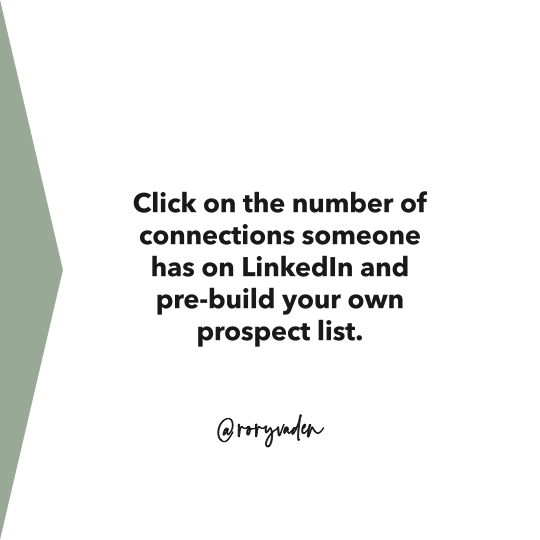How to Sell
It’s pretty common to be a little bit nervous when it comes time to sell something.
Sales have a little bit of a complicated reputation, I would say.
For a lot of us, selling feels awkward and uncomfortable, especially if you’ve never been formally trained.
This is something that we address in some of the latter parts of the Brand Builders Group curriculum. We’ve got two different events, one called Pressure Free Persuasion (Phase 3) which is all about how to sell in a pressure-free way. And then our Phase 4 event, called Scale Your Sales, which is about how to build a sales team to do the selling for you and what it takes to look like to manage a team.
What I want to share with you today is one unexpected way to reduce the pressure that you feel when it comes to selling.
I want to share this idea with you because this is a very tactical part of a professional sales process that you don’t hear that often.
Almost nobody teaches you about this core fundamental concept.
And if you don’t understand this concept, then here’s what happens.
Sales become intimidating.
The concept of selling can be intimidating. It can be overwhelming.
There’s this idea that somehow, you’ve got to convince somebody to do something against their will and that can feel scary if you don’t know how to do it.
Here is the concept that I want to introduce to you.
How to Track Sales

It is the concept of sales pipeline stages.
What are sales pipeline stages?
Super simple.
By the way, this concept I would say is a very popular B2B (business-to-business) concept. A true professional, in the B2B sales, almost would never work for an organization that didn’t have a clear understanding of its sales pipeline. If they did, it would be one of the very first things that a good sales consultant would address.
But it’s not something that you hear that often about in B2C selling– business to consumer selling.
And most of you, as personal brands, there are at least some components of your business where you’re selling in a B2C environment, meaning you’re selling to individuals, not in a B2B environment where you’re selling to large companies.
There are some things that you will sell maybe to companies, but a lot of us that are personal brands, we’re selling to a person which is a much simpler sales process.
And just in terms of the ability for someone to make a decision, when you sell to a company, typically it’s a complex sale. There are multiple decision-makers. There are many people you have to coordinate with. And even though they have a lot more money, it’s typically a more complicated sales process.
But one of the things that happens all the time in B2B selling is the mapping of sales pipeline stages.
If you can map sales pipeline stages, then this has some incredible benefits for you.
There are four main reasons why I think you should consider doing this.
The first reason is it helps reduce pressure. Having pipeline stages reduces pressure.
What pipeline stages are like a series of checkpoints. You can almost think of them as a series of stoplights.
If you think about making a sale, that’s kind of a big idea.
You have to make somebody aware of something that maybe they’re not aware of.
Then you have to help them become interested in it. And then you have to get to know them. Then you have to figure out if what you have is a good fit for them; then you have to talk to them about the price.
Then you have to get them to agree to that price. Then you have to collect the money from them. And then you probably have to collect some type of an agreement from them that gets signed. And then you have a completed or a closed sale.
All of those parts are distinct, separate parts so when you create a sales pipeline, all you’re going to do is take this big idea of a sale, and you’re going to split it up into stages like that. We like to think of it as a series of stoplights.
When you do this, this reduces pressure on both you and your prospect.
How?
Well, it’s simple. It reduces pressure on you because it takes the intimidation out of having to talk to this stranger and suddenly convert them into someone who’s giving me money and signing an agreement.
That’s a big leap in a lot of cases.
Breaking it up into smaller steps makes it feel more manageable. It’s less intimidating.
It’s more doable, but it also puts less pressure on your prospects.
Why?
Because you’re not trying to fast-forward them to the end.
What you’re doing, which is a big part of pressure-free persuasion, is you’re moving them in a very gradual way towards the decision.
You’re only moving them towards the next checkpoint or the next stoplight versus trying to fast-forward them to buying.
That is a very natural way for people to make decisions. It’s a very comfortable way and it’s a very effective way to help people make decisions.
The second reason why you probably want to create a sales pipeline stages outline for your business is that it allows for systematic tracking.
Again, in a B2B environment, people would look at a pipeline and manage the pipeline. They know exactly how many prospects they have in each of these stages in their process, typically tracked in some type of a CRM system, a customer relationship management tool.
Small businesses should do this too. Why? Because then you know exactly how many people you have in each stage.
What you don’t want to do is this. What a lot of entrepreneurs do is wake up one day and they look at the financial statements and realize that they didn’t make any sales last month.
You should never be caught off guard by that because you should never just be managing how many deals are coming to close.
You should be managing the entire pipeline. You should be managing the entire process.
And if you’re doing that, you’ll never be caught by surprise because you always know how many people are all the way back here, moving through your funnel systematically.
The other thing is that if you create these stages and you track them, it allows you to measure the average length of time that people stay in each stage. There are lots of different tools for that.
Once you do that, it allows you to create an accurate prediction of future revenue. You can look at how many people you have in each stage, and you can predict based on averages.
What percentage of those people typically move from one stage to the next? And how long does it take them to move from one stage to the next? This allows you to forecast in a pretty accurate way. How much revenue is forecasted to come in based on your current pipeline? Huge enterprises’ sales teams do this all the time, but for small businesses that have never been in sales, they don’t know to do this, and it catches them by surprise.
This leads to the third reason why you want to have sales pipeline stages for your business.
It allows and enables you to create systematic training for your team. You can pinpoint and identify specific gaps in specific things that move the needle in each stage of the sales process.
And you can see that 40% of the people in stage 1 make it to stage 2, but only 5% of the people make it from stage 2 to stage 3. That enables you to identify that gap and ask the question of why is that happening?
You ask questions, explore it, and find answers to why that’s happening which allows you to optimize it.
But if you don’t have pipeline stages and you’re not managing it, then it’s not going to happen. You’ll never identify those things.
And that leads to the fourth reason why you want to have sales pipeline stages.
They ensure better follow-up.
When you build a sales pipeline and have all these stages, somebody should be reviewing it every single week.
The salespeople should be doing this. The sales manager should be doing this so that you’re constantly asking the question of what’s going on with Sally Jones? Why has she been stuck here in stage 2 for so long? And how many people do we have in stage 4? What can we do to move them to close and how come there are not enough people here in stage 1? Where can we ask for referrals to get more people into stage 1?
And you have a better follow-up with your sales team in terms of managing them.
Then your sales team has a better follow-up with your customers because they know exactly who to follow up with. They know where people are at.
The scariest thing of all, when it comes to building a sales team, is the unpredictability of your revenue.
It’s intimidating to make a sale, but it’s even scarier to not have any idea of how much revenue is coming in.
If you build pipeline stages for several reasons more, even than just these four that we’ve talked about here, you will create more predictable revenue as well as less pressure and intimidation for both you and your prospects.

















